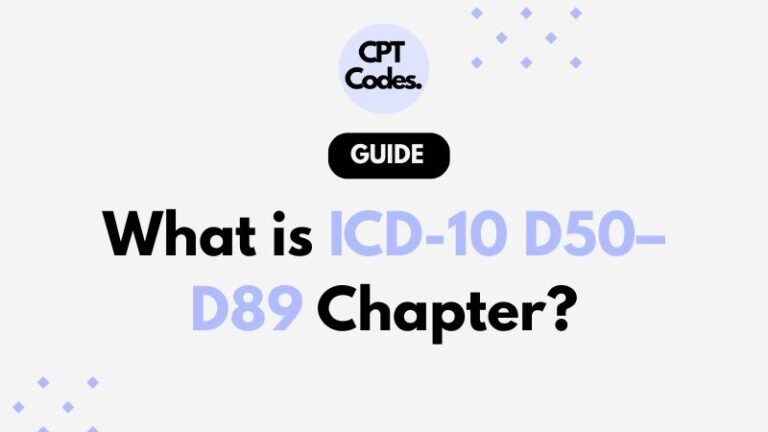The ICD-10 range D50 through D89 covers conditions that affect blood cells, bone marrow, coagulation, the spleen, and immune function. It is a crucial chapter in medical classification because it groups many hematologic and immunologic disorders under a systematic code structure.
Major Sections Overview
| Code Range | Category | What It Covers |
|---|---|---|
| D50–D53 | Nutritional anemias | Anemias caused by deficiencies such as iron, B12, and folate |
| D55–D59 | Hemolytic anemias | Disorders where red blood cells are destroyed prematurely |
| D60–D64 | Aplastic and other anemias / bone marrow failure | Conditions where the marrow fails to produce sufficient blood cells |
| D65–D69 | Coagulation defects and hemorrhagic conditions | Bleeding disorders, clotting factor deficiencies, purpura |
| D70–D77 | Other blood disorders | Neutropenia, white blood cell disorders, spleen diseases, and more |
| D78 | Spleen complications during or after procedures | Surgical or procedural harm to the spleen |
| D80–D89 | Disorders involving the immune mechanism | Immunodeficiencies, hypersensitivity, and other immune dysfunctions |
Each of these categories holds subcodes for more specific diagnoses. For example, iron deficiency anemia includes D50.0, D50.1, D50.8, and D50.9.
Key Examples Nutritional Anemias (D50–D53)
These codes deal with anemias resulting from dietary or absorption issues. Notable ones are:
- D50.0: Iron deficiency anemia due to chronic blood loss
- D50.1: Sideropenic dysphagia (difficulty swallowing linked to iron deficiency)
- D50.8 / D50.9: Other or unspecified iron deficiency anemias
- D51: Vitamin B12 deficiency (various subtypes)
- D52: Folate deficiency
- D53: Other nutritional anemias not elsewhere classified
These are common in clinical practice and often relate to diet, bleeding, or malabsorption.
Hemolytic Anemias (D55–D59)
These are conditions where red blood cells break down too early. They include:
- Genetic enzyme defects such as G6PD deficiency
- Sickle cell disease
- Acquired immune hemolysis
- Hereditary red cell membrane or enzyme abnormalities
Symptoms can include jaundice, fatigue, and anemia, often with episodes of acute crisis in severe cases.
Bone Marrow Failure & Aplastic Anemias (D60–D64)
These disorders occur when bone marrow cannot produce enough blood cells. Examples include:
- Pure red cell aplasia and congenital marrow defects
- Aplastic anemia from chemicals, radiation, or unknown causes
- Anemia following acute hemorrhage or chronic disease
- These conditions are often serious and may require bone marrow transplantation or long-term therapy.
Coagulation & Hemorrhagic Disorders (D65–D69)
This section covers disorders related to clotting and bleeding:
- Disseminated intravascular coagulation (DIC)
- Hemophilia A (factor VIII deficiency)
- Hemophilia B (factor IX deficiency)
- Purpura and platelet function disorders
Accurate coding here is vital for managing bleeding risks and guiding treatment.
Other Blood Disorders (D70–D77)
This group includes various conditions affecting blood and spleen function, such as:
- Neutropenia (low neutrophil count)
- Leukocytosis and other white blood cell disorders
- Splenic enlargement and functional disorders
- Methemoglobinemia (abnormal hemoglobin)
- Miscellaneous other blood-related diseases
These codes are used when a condition doesn’t fit into the other major categories.
Procedural Spleen Complications (D78)
These codes describe complications involving the spleen that occur during or after surgery or medical procedures. Although less common, they are essential for documenting surgical outcomes and managing post-operative care.
Immune Mechanism Disorders (D80–D89)
These include a wide range of immune dysfunctions:
- Primary immunodeficiencies
- Combined immunodeficiencies
- Common variable immunodeficiency (CVID)
- Antibody deficiencies
- Sarcoidosis and other immune regulation disorders
- Mast cell activation and hypersensitivity conditions
These codes help track immune disorders that may cause recurrent infections or abnormal inflammatory responses.
Why This Chapter Matters
ICD-10 codes D50–D89 provide a standardized way to classify and record blood and immune disorders. This chapter supports:
- Accurate clinical diagnosis and documentation
- Better understanding of disease prevalence and outcomes
- Correct medical billing and insurance processing
- Research into blood and immune health trends
Blood and immune disorders often overlap, so the ICD-10 structure ensures each condition, from anemia to immune deficiency, has a defined place. Specificity in coding is key: more precise diagnoses improve patient care and data accuracy.

